|
Grumman F-14A Tomcat
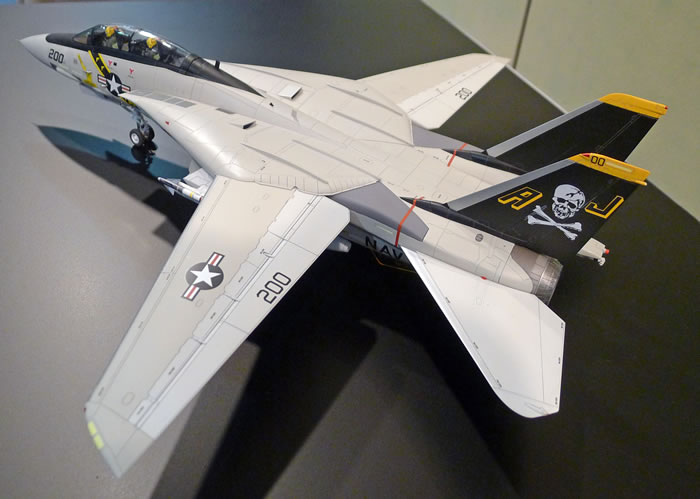
Tamiya, 1/48 scale
S
u m m a r y |
| Catalogue Number: |
Tamiya Kit No. 61114 - Grumman F-14A Tomcat |
| Scale: |
1/48 |
| Contents and Media: |
373 parts in light grey plastic (257 for the airframe plus 116 for weapons); six parts in clear plastic; five screws; two washers; four polythene caps; one masking sheet; two decal sheets. |
| Price: |
TBA |
| Review Type: |
Test Shot Preview |
| Advantages: |
Accurate; high level of detail; outstanding surface features including crisply recessed panels and subtle rivet lines where appropriate; useful options including moveable swing wings; poseable crew steps, ladder and canopy, optional position refuelling probe and more; clever and modeller-friendly parts breakdown; will include canopy masks. |
| Disadvantages: |
|
| Conclusion: |
This 1/48 scale F-14A Tomcat continues Tamiya's proud tradition of accurate, well-detailed, thoughtfully designed and modeller friendly kits. Surface textures are beautifully restrained and the design of the swinging wings with their separate wing gloves is very clever.
If you really need a Tomcat with dropped slats and flaps, you already have the Hasegawa and HobbyBoss kits that offer this option.
It is true that there have been plenty of 1/48 scale Tomcat kits before now, but this is the first time that we have a Tamiya Tomcat; and that means an accurate, well detailed and cleverly engineered kit that you will be able to build without turning the air blue around you.
Highly Recommended. |
Reviewed by Brett Green

Tamiya's 1/48 scale F-14A Tomcat will be available online from Squadron.com
The Grumman F-14 Tomcat is a supersonic, twin-engine, two-seat, variable-sweep wing fighter aircraft. The Tomcat was developed for the United States Navy's Naval Fighter Experimental (VFX) program following the collapse of the F-111B project. The F-14 was the first of the American teen-series fighters, which were designed incorporating the experience of air combat against MiG fighters during the Vietnam War.
The F-14 first flew in December 1970 and made its first deployment in 1974 with the U.S. Navy aboard USS Enterprise (CVN-65), replacing the McDonnell Douglas F-4 Phantom II. The F-14 served as the U.S. Navy's primary maritime air superiority fighter, fleet defense interceptor and tactical aerial reconnaissance platform. In the 1990s, it added the Low Altitude Navigation and Targeting Infrared for Night (LANTIRN) pod system and began performing precision ground-attack missions.
In the 1980s F-14s were used as land-based interceptors by the Islamic Republic of Iran Air Force during the Iran–Iraq War, where they saw combat against Iraqi warplanes. Iranian F-14s reportedly shot down at least 160 Iraqi aircraft during the war, while only 12 to 16 Tomcats were lost; at least half of these losses were due to accidents.
The Tomcat was retired from the U.S. Navy's active fleet on 22 September 2006, having been supplanted by the Boeing F/A-18E/F Super Hornet. The F-14 remains in service with the Islamic Republic of Iran Air Force, having been exported to Iran in 1976, when the U.S. had amicable diplomatic relations with Iran.*
Another Tomcat?
Who says history never repeats?
I recall back in 2002 when Tamiya revealed that they would be releasing a new-tool 1/48 scale Messerschmitt Me 262, there were howls of anguish that we didn’t need another Me 262; that the Dragon kit was perfectly good; and why didn’t Tamiya give us an (insert your personal favourite aircraft here) instead?
Not surprisingly, when Tamiya’s kit was released it was better detailed, had more options and was far easier to build than Dragon’s offering.
Fast forward to the end of 2002 and there were even louder complaints when Tamiya’s forthcoming 1/48 scale P-47D Thunderbolt was announced. What was wrong with the Hasegawa kit? Surely Tamiya should release an (insert your personal favourite aircraft here) instead.
Of course, Tamiya’s resulting family of P-47 Thunderbolts are now acknowledged to be some of the best 1/48 scale plastic kits ever released.
The same pattern repeated itself with Tamiya’s 1/48 scale Heinkel He 162 A-2 in 2006, A6M5 Zero in 2008 and the Il-2m in 2012, but once again in each case Tamiya delivered a kit with clever engineering, great detail and effortless construction - clear improvements over their predecessors.
So here we are again on the same old road. Surely we don’t need a new 1/48 scale F-14A Tomcat...
Or do we?
Let’s see if what Tamiya has up its sleeve with this latest release.
Tamiya has sent a set of test-shot sprues for their forthcoming 1/48 scale F-14A Tomcat, due for release later this year.
The kit comprises 373 parts in light grey plastic (257 for the airframe plus 116 for weapons), six parts in clear plastic, five screws, two washers, four polythene caps, one masking sheet and two decal sheets.
Tamiya's release represents an early production version of the F-14A without the TCS fairing under the nose.
Moulding quality is perfect. Surface detail is some of the best that you will ever seen in 1/48 scale, mainly by way of very finely recessed panel lines, with some selective rivets and raised detail. The panel lines are comparable to scaled-down versions of the surface detail on Tamiya's benchmark 1/32 scale kits.
Please note that the surface detail looks better in person - it is difficult for the photographs to full justice to the gorgeous panel lines on the pale coloured plastic.
The complex design of the F-14A is built up around a pair of stout toothed gears for the swing wings, held securely in place with screws. This design will ensure that the swing action of both wings is synchronised. Each side of the variable sweep mechanism is moulded with a long reinforced locating tongue for the wings themselves.
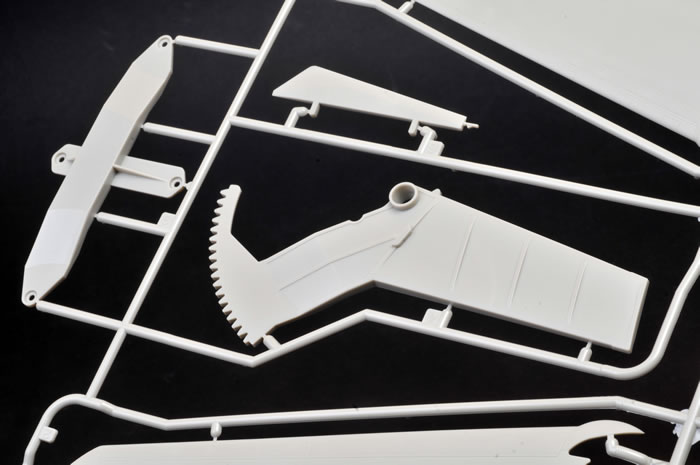
The variable sweep mechanism is later sandwiched between the upper and lower mid-fuselage sections to form the core of the model.
The forward fuselage is broken down into port and starboard halves. The cockpit sub-assembly is trapped between these halves. The nose features optional position crew steps, crew ladder and a separate refuelling probe.
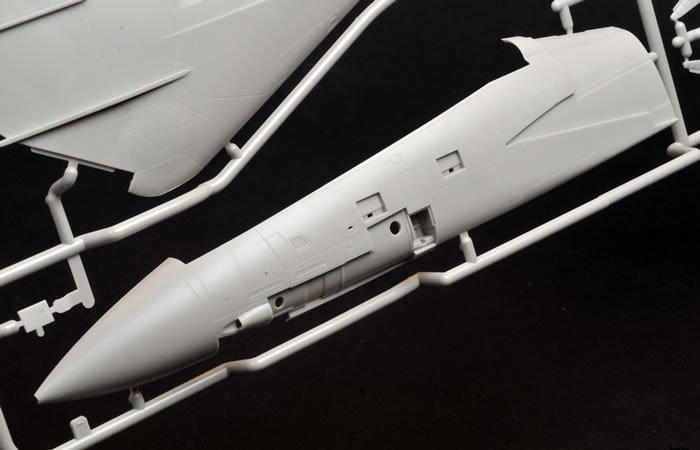
Detail is excellent throughout. The cockpit features a blank cockpit tub with separate panels for consoles and sidewalls. Instrument panels are a combination of raised moulded detail, a clear part for the radar scope, and a number of decals for the CRT screens.
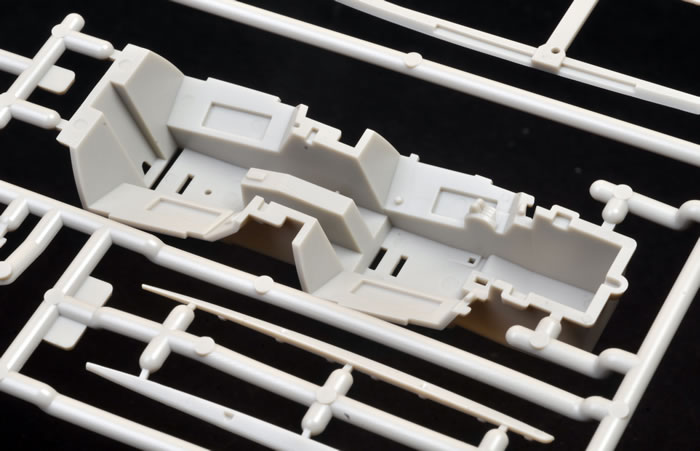
The seats are well detailed, being made up from seven parts each. Two pilot figures are supplied (they have different arms and heads for individuality), but decal harness straps are also included if the crew figures are not used.
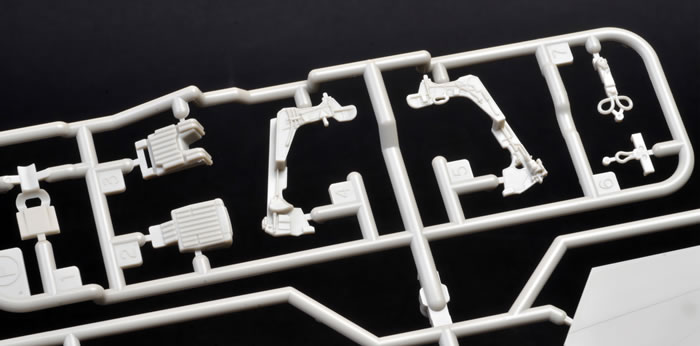
Intakes and exhausts are full length with fan and flame holder detail at the ends. Tamiya supplies two open and two closed exhaust nozzles, with the instructions directing that one of each should be fitted.

Wheel wells are made up from separate panels. The landing gear is well detailed and the wheels are all injection moulded plastic - no vinyl tyres here.
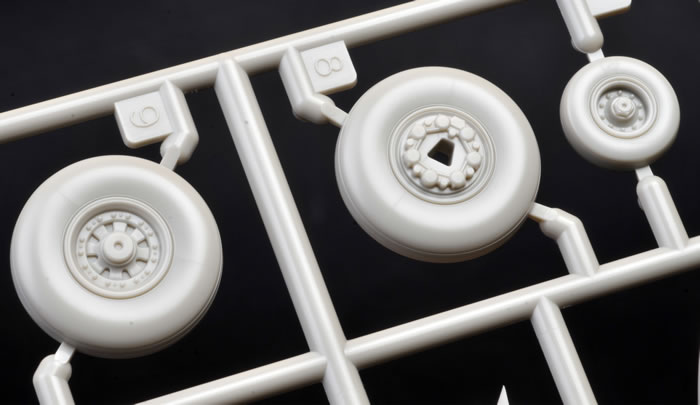
Each wing is moulded as a simple upper and lower half with all control surfaces including flaps and slats shut. Having said that though, the hinge line detail on the upper wings is particularly well done. Once assembled, each wing simply slips over the large reinforced tongue, which is an extension of the variable sweep mechanism.
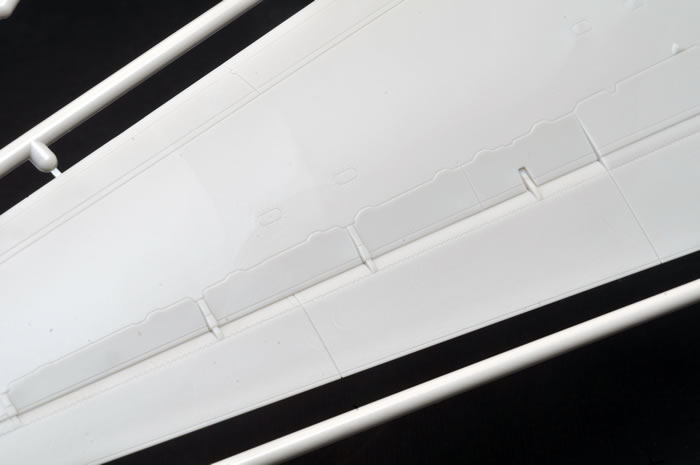
Once the wings are fitted, the glove vanes and sealing plates may be installed. There are different parts supplied for wings swept forward or wings swept back, and they are designed to be fitted without adhesive so that the wing configuration may be changed even after the model is built and painted.
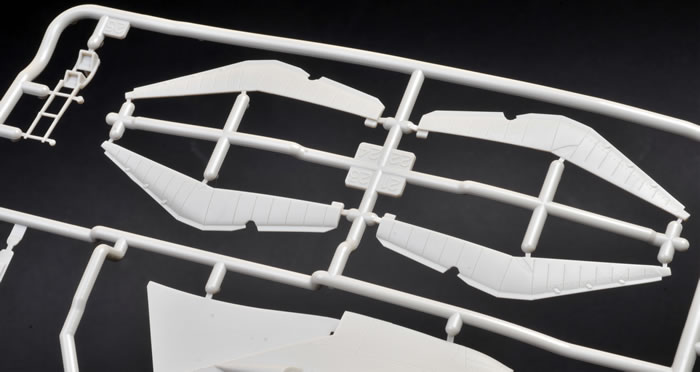
Clear parts are thin and free from distortion. The sprues offer some protection to the canopy parts during transport too - a nice touch. The windscreen is moulded with a clear section of the upper nose, so there is virtually no risk of messy glue marks on the finished model.
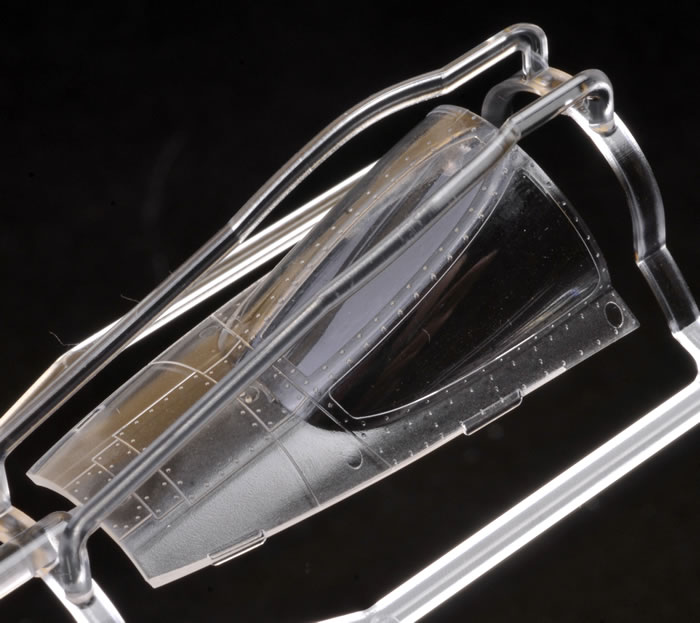
The comprehensive weapons sprues include AIM-7E Sparrow missiles, AIM-9G/H Sidewinders and AIM-54A Phoenix missiles. The Sidewinders are split into forward and rear sections. The sprues also appear to have the forward halves of later Sidewinders too.

A sheet of self-adhesive canopy masks will be included with the production kit.
Markings
Markings are supplied for three aircraft:
-
VF-84 "Jolly Rogers" CAG Bird, 1979 (USS Nimitz)
-
VF-2 "Bounty Hunters", 1976 (USS Enterprise)
-
Islamic Republic of Iran Air Force, Tactical Fighter Base 8, 1980.

The decals here are early test printings onto solid sheets of decal film. Colours and registation look good.

A second decal sheet includes stencils, harness straps, CRT displays and markings for the weapons.
This 1/48 scale F-14A Tomcat continues Tamiya's proud tradition of accurate, well-detailed, thoughtfully designed and modeller friendly kits. Surface textures are beautifully restrained and the design of the swinging wings with their separate wing gloves is very clever.
There have been a number of comments online about the lack of a dropped flap option, but Tamiya has clearly made a conscious decision to offer a fairly straightforward build and the rather nice feature of workable variable sweep mechanism instead.
If you really need a Tomcat with dropped slats and flaps, you already have the Hasegawa and HobbyBoss kits that offer this option.
It is true that there have been plenty of 1/48 scale Tomcat kits before now, but this is the first time that we have a Tamiya Tomcat; and that means an accurate, well detailed and cleverly engineered kit that you will be able to build without turning the air blue around you.
Highly Recommended.
(Please note that there may still be some changes made to the test shot sprues seen here. Also note that the title image is a mock-up on display at the Shizuoka Hobby Show)
*Background information courtesy of Wikipedia
Thanks to Tamiya for the sample
Review Text Copyright © 2016 by
Brett Green
Page Created 21 July, 2016
Last updated
22 July, 2016
Back to HyperScale Main Page
Back to Reviews Page |
